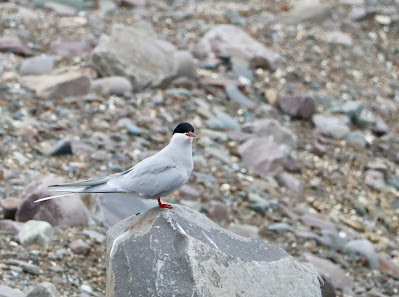It always seems that whenever I get to gulls and terns I become very serious. In my early blogging days I might not have even bothered to include gulls. But ever since I became the proud owner of The Gull Guide North America (2024) (it can be purchased for $29.85 from Thriftbooks) by Amar Ayyash and also heard him give his Keynote Address, Man and Gulls at the BWIAB conference this past Mother's Day, I feel differently about gulls. That's a good thing. My review, from last October, of Amar's book is here. The YouTube link is Amar's Man and Gulls Keynote Address at a different conference (1 hr, 5 mins long) than the one I attended.
Above and two below: Mew Gull (Larus canus)? No. Short-billed Gull (Larus brachyrhynchus)? No. Common Gull (Larus canus)? Yes. In 2021 the AOS split the Mew Gull into Short-billed Gull (North America) and Common Gull (Eurasia) due to finding genetic, morphological, and vocal differences between the two species. As already discussed, what's in a name? Brachyrhynchus originates from Greek meaning short-billed or short-beaked. I'm surprised to write this, but I think Common Gull was my favorite gull of the trip, even though this is not what I was expecting going into the trip. I think it's a very pretty gull. I included the not great photo above, because I like photos of gulls on unexpected perches. Common Gull was a common bird on the trip but these are my only photos. They were taken in the same location as the Siberian Tit.
Above and two below: Little Gull (Hydrocoloeus minutus)
I thought this would be my favorite gull of the trip and I do like it very much. We saw hundreds. I took a lot of photos and tried hard to get good photos. I selected these randomly. The dark eye in the dark head conspired against me with so many different birds on this trip. Of the three here, I think I like the middle photo best - a little gull flying past a nesting Whooper Swan (Cygnus cygnus), of which we also saw nearly everywhere.
Above and below: Black-headed Gull (Chroicocephalus ridibundus), even though its head is brown.
You can see the tiny insects on the water's surface that Little and Black-headed gulls were feasting on. I think of this gull as being like our Ring-billed Gull - it's everywhere, even in parking lots.
Above: Black-legged Kittiwake (Rissa tridacyla) colony occupying an abandoned - by humans - fishing hut of some sort in Båtsfjord. If there was a ledge of any width or any place to perch it was occupied by kittiwakes on all sides of this building. They were a raucous bunch.
Kittiwake taking a break from the noise and competition.
Great Black-backed Gull (Larus marinus). We saw them often.
Above and two below: European Herring Gull (Larus argentatus).
I have always liked terns but find the
Sternas difficult to identify. A couple of years ago I added Cameron Cox's
Terns of North America: A Photographic Guide (2023) to my bookshelf (currently 30% off with Princeton). Earlier this spring I confused a Forster's Tern (
Sterna forsteri) for a Common Tern (
Sterna hirundo) on this blog and I was, after a few weeks, corrected by the eBird moderator. Now I think Common Tern and Arctic Tern (
Sterna paradisaea) are a more confusing pair. I think the 2nd edition
Birds of Europe doesn't really help my confusion (pages 200-201) and I have considered that these two terns may have slightly different features in northern Europe. I pulled Cox's book off the shelf to write this entry. My photos aren't dreadful, but none are particularly good either. Again, there is my problem of the black eye in the black head feathers.
Two photos above and one below: Common Term (Sterna hirundo).
The wide, white leading edge on the anterior wing (shoulder?) is a key feature in these photos. Arctic tern also has a white leading edge but it is much less prominent. Having pointed this out in my photos, I can't find a single stationary bird photo in Cox's book that shows this. In many of his flight photos it's very prominent. The bill is also darker red than I would expect it to be. When all else fails, as it seems here, I went to my trusty evening checklist. Our guides identified Common Tern. This was at Kuusomojavi Harbor, our first stop on May 27th.
Above and below: Arctic Tern (Stern paradisaea).
This bird was part of a noisy flock that were wheeling around the rocks in Persfjord in Norway on June 2nd I feel comfortable with this ID because in these final days of the trip, we were only seeing Arctic Terns. Also, I had the presence of mind to open Merlin and confirmed their vocalizations.
This seems like a very scholarly post and I am completely unqualified to write anything scholarly about gulls or terns. I guess this is what gulls and terns do to me.





















No comments:
Post a Comment